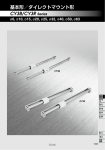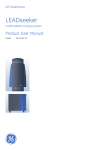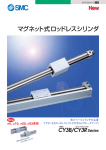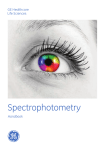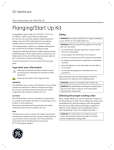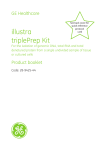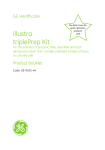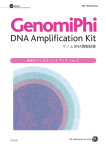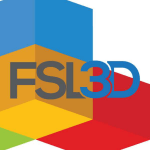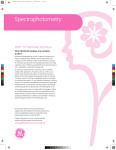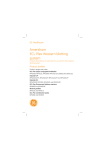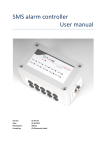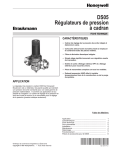Download NanoVue™ Plus Spectrophotometer
Transcript
GE Healthcare Data file 28-9301-69 AC UV/Visible spectrophotometers NanoVue™ Plus Spectrophotometer NanoVue Plus Spectrophotometer (Fig 1) is a stand-alone instrument with a novel drop-and-measure sample plate that can be used with a wide range of chemicals. NanoVue Plus can be used for the accurate and reliable quantitiation of nucleic acids and protein samples. The ability to pipette samples of 0.5 to 5 μl directly onto the sample plate eliminates the need for cuvettes or other sample devices. After measurement, the sample can either be easily recovered with a pipette or quickly discarded by wiping the sample plate clean for the next measurement. NanoVue Plus is pre-programmed with a range of preset methods for the quantitation of nucleic acids and proteins, using UV or dye-intercalation methods (Lowry, Bradford, BCA, and Biuret). In addition, wavelength scanning gives you the flexibility to design your own methods, which can be stored in a personal folder for easy access. The instrument does not require a computer because it has a direct user interface. Fast instrument start-up with automatic selfcalibration means NanoVue Plus Spectrophotometer is always ready to use. NanoVue Plus Spectrophotometer offers: • Novel gold-colored hydrophobic sample plate: Save time and effort by directly pipetting your sample onto the sample plate for measurement. The hydrophobic coating facilitates sample recovery and minimizes the potential for contamination of the sample mechanism thus improving data precision (Fig 2). The plate is compatible with a wide range of chemicals including DMSO and DMF • Low sample volumes: Reduce sample loss and eliminate the need for dilution by using low volumes of 0.5 to 5 μl for sample measurement. The appropriate pathlength for your sample volume is selected automatically unless you opt for manual selection • Fast measurements: Read-time is typically < 5 s per sample and you save more time by not having to wash cuvettes or dilute samples imagination at work Fig 1. NanoVue Plus Spectrophotometer uses a novel drop-and-measure sample plate which eliminates the need for cuvettes. • Convenience and ease of use: Large, high-resolution graphical display enables a quick read of relevant results. Calibration curves, kinetics or ratio measurements are all displayed at the touch of a button (Fig 3) • Flexible analytical performance: Full wavelength scan in less than 5 s from 200 to 900 nm with zoom facility, peak identification, and on-peak confirmation. Visualization of nucleic acid scans allows impurities to be detected and this is especially useful with RNA samples • Choice of data output: Print to an integrated printer (optional) or to any suitable PC via a USB, wireless (Bluetooth) connection or SD card • Reliability and robust instrumentation: Press-to-read feature reduces the amount of time the lamp stays switched on. Optics with no moving parts minimizes the incidence of optical misalignment Assays BSA carry over data (mg/ml) 30 25 Nucleic acids 20 NanoVue Plus Spectrophotometer allows you to measure the concentration and purity of nucleic acids in a variety of units (μg/ml, ng/μl, μg/μl, pmol/μl, and pmol) and also, to correct for dilution factors where necessary. 15 10 5 0 0 5 10 15 20 25 Sample number water pre BSA sample BSA sample water post BSA sample Fig 2. Sample carry over study using 25 mg/ml BSA with successive additions of a water-protein-water cycle of samples, which was repeated 25 times. The data showed no significant change in absorbance readings during the study for water sample readings or BSA samples readings thus indicating that there was no sample carry over. NanoVue Plus 1 Life Science - Protein 2 Life Science 3 Applications 4 1 Protein UV 5 Methods 2 Favourites 4 5 Utilities Bradford (A) 3 Protein A280 BCA 6 Lowry Biuret (B) DNA 1.53 A A260 2.39 A A280 0.94 A A320 0.18A A260/A280 2.908 You can examine the UV spectrum (220 to 330 nm) for hybridization, PCR, and sequencing studies or for quantitation of minipreps after isolation by chromatography. The instrument enables you to characterize oligonucleotide primers by keying in the base sequence (up to 66-mer) to obtain a conversion factor (μg/ml), molecular weight, theoretical absorbance (AU/μmol), and theoretical Tm. DNA linearity Wavescan 0.4 A230 NanoVue Plus displays both individual absorbance values and absorbance ratios (260/280 and 260/230) on the screen, along with the sample concentration value. A graphical display of the result is also available at the touch of a button. The results can be printed immediately with the on-board printer option. Sample 1 0.3 Concentration 0.2 110.5 A260/A280 Units 1.637 µg/ml 0.1 240 λ 260 261 271 280 Abs 0.171 0.204 0.104 Sample 4 (C) 300 320 318 λ 285nm A 0.036 A (D) NanoVue Plus shows excellent linearity with double-stranded DNA (dsDNA) from 5 to 6000 µg/ml (Fig 4). This large linear dynamic range and high reproducibility means that you can proceed to the next stage of your workflow with a high degree of confidence in the data produced by NanoVue Plus Spectrophotometer. Fig 3. NanoVue Plus spectrophotometer screenshots showing; (A) Simple interface for easy selection of applications; (B) Protein methods interface; (C) DNA quantitation results and (D) An example of a wavelength scan. Table 1. Features of NanoVue Plus Spectrophotometer Feature Specification Wavelength range 200 to 1100 nm Wavelength calibration Automatic upon switch on Pathlength selection Automatic with the option for manual selection Stored methods 90 Spectral bandwidth 5 nm Wavelength accuracy ± 2 nm Wavelength reproducibility ± 0.5 nm Absorbance accuracy Maximum ± 1% (at 259 nm) at 0.7 to 0.8 A using uracil Light source Long-life stabilized Xenon Detector Twin CCD Array Dimensions 260 × 390 × 100 mm Weight 4.5 kg Power requirements 100 to 240 VAC ± 10%, 50/60 Hz, 50 VA Note: Technical specifications were measured after the instrument had warmed up at a constant ambient temperature. 2 28-9301-69 AC 5 Calculated value (mg/ml) The key features of NanoVue Plus Spectrophotometer are summarized in Table 1 below. 6 4 3 r2 = 0.9975 2 1 0 0 1 2 3 4 5 6 DNA (mg/ml) Fig 4. DNA concentration curve (0.5 to 6000 µg/ml) generated from salmon sperm dsDNA samples measured at 260 nm using NanoVue Plus [n = 20 replicates; mean ± 1 standard deviation (SD)]. Proteins 50 Protein concentration can be determined in the near UV at 280 nm due to absorption by tyrosine, tryptophan, and phenylalanine amino acids. The absorbance at 280 nm varies greatly for different proteins because of their amino acid content therefore, the specific absorption value for a particular protein must be determined. NanoVue Plus has in-built extinction coefficients for BSA, IgG, and lysozyme thus allowing you to select the most appropriate for your protein sample or you can input your own extinction coefficients. Typical results for BSA and IgG values using the absorbance at 280 nm program are shown in Figures 5 and 6, respectively. Calculated value (mg/ml) 75 50 r2 = 0.9997 10 20 30 40 50 60 20 r2 = 0.9999 10 0 0 10 20 30 40 50 IgG (mg/ml) Fig 6. Protein concentration curve (0.025 to 50 mg/ml) generated from bovine IgG samples measured at 280 nm using NanoVue Plus protein absorbance 280 program with IgG preset option (n = 20 replicates; mean ± 1 SD). Background correction CyDye™ 25 0 30 NanoVue Plus provides increased confidence in your results by allowing you to use the background correction feature at 320 nm to compensate for the effects of background absorbance caused by turbidity, stray particulates, and high-absorbance buffer solutions. This feature of the instrument is critical because very small samples are susceptible to stray particulates. The results are displayed on the screen with other absorbance results for quick evaluation. You have the flexibility to turn the background correction function on or off. 100 0 40 Calculated value (mg/ml) NanoVue Plus Spectrophotometer can be used to determine the concentration of protein samples by a variety of methods including Bradford, BCA , Lowry, Biuret, and direct UV methods with a choice of line fit and the ability to run up to 27 standards (including replicates). These calibration curves can be viewed on the graphical display, printed or stored as a method for future use. 70 80 90 100 BSA (mg/ml) Fig 5. Protein concentration curve (0.01 to 100 mg/ml) generated from BSA protein samples measured at 280 nm using NanoVue Plus (n = 20 replicates; mean ± 1 SD). You can also measure purity, yields, and brightness of fluorescently labeled in-situ hybridization probes. CyDye DNA function holds spectral data for 19 commonly used dyes, including Cy™2, Cy3, Cy3B, Cy5, and Amersham™ Hyper™5 and both sample concentration and frequency of incorporation measurements are presented. Calibration An accurate pathlength distance is important for the correct functioning of all low volume spectrophotometers. We recommend a regular pathlength check as a matter of good laboratory practice. The pathlength calibration fluid supplied with the instrument allows for simple checking of the instrument pathlength whenever convenient for added confidence in performance. Should re-calibration be necessary, you can easily and quickly recalibrate NanoVue Plus in your laboratory without the inconvenience and cost of sending the instrument away. 28-9301-69 AC 3 Drop. Measure. Done. Ordering information NanoVue Plus provides intelligent performance across all spectrophotometry applications (Fig 7). Product 1. Just pipette your sample onto the sample 2. Lower the sample plate head 3. Read your result NanoVue Plus with integrated printer (US & CA only) 28-9569-63 NanoVue Plus with integrated printer (Worldwide except US & CA) 28-9569-66 NanoVue Plus, print via computer (US & CA only) 28-9569-62 NanoVue Plus, print via computer (Worldwide except US & CA) 28-9569-65 NanoVue Plus with wireless connectivity (US & CA only) 28-9569-64 1. Protein UV A260 Sample 2.33 A 1 A280 Result 0.92 A A320 0.000 A 386 Units 2. Code No. 3. µg/ml Fig 7. Operation of NanoVue Plus Spectrophotometer. Summary NanoVue Plus Spectrophotometer is an easy-to-use and reliable instrument for measuring nucleic acid and protein samples. Samples of 0.5 to 5 μl can be pipetted directly onto a novel sample plate for measurement, and then simply recovered using a pipette. In certain cases where sample recovery is not necessary, the sample plate can be quickly and easily wiped clean. This novel feature eliminates the need for cuvettes, capillaries or other sample devices— just drop, measure, and you’re done. NanoVue Plus with wireless connectivity (Worldwide except US & CA) 28-9569-67 NanoVue Plus with SD card (US & CA only) 28-9569-61 NanoVue Plus with SD card (Worldwide except US & CA) 28-9569-60 Pathlength calibration kit (Worldwide) 28-9244-05 Sample Plate Replacement Kit 28-9569-58 Lower Sample Plate Replacement Kit 28-9569-59 Related products Ultrospec 10 Cell density meter 80-2116-30 illustra™ plasmidPrep Mini Spin Kit 28-9042-69 illustra GenomiPhi™ V2 DNA Amplification Kit 25-6600-30 illustra RNAspin Mini Kit 25-0500-71 illustra HotStart PCR Master Mix 25-1500-01 illustra GFX PCR DNA and Gel Band Purification Kit 28-9034-70 ™ GE, imagination at work, and GE monogram are trademarks of General Electric Company. For local office contact information, visit www.gelifesciences.com/spectros GE Healthcare UK Limited Amersham Place Little Chalfont, Buckinghamshire HP7 9NA, UK www.gelifesciences.com Amersham, Cy, CyDye, GenomiPhi, GFX, HyPer, illustra, and NanoVue are trademarks of GE Healthcare companies. CyDye: This product or portions thereof is manufactured under an exclusive license from Carnegie Mellon University under US patent number 5,268,486 and equivalent patents in the US and other countries. Cy3-UTP or Cy5-UTP, Cy3.5-dCTP or Cy5.5-dCTP, Cy3-CTP or Cy5-CTP: These products are manufactured for GE Healthcare UK Limited by Perkin Elmer Life Sciences under US patent numbers 5047519 and 5151507.. The cyanine dyes in the product are manufactured under an exclusive license from Carnegie Mellon University under US patent numbers 5,268,486 and equivalent patents in the US and other countries. The purchase of CyDye products includes a limited license to use the CyDye products for internal research and development but not for any commercial purposes. A license to use the CyDye products for commercial purposes is subject to a separate license agreement with GE Healthcare. Commercial use shall include: 1. Sale, lease, license or other transfer of the material or any material derived or produced from it. 2. Sale, lease, license or other grant of rights to use this material or any material derived or produced from it. 3. Use of this material to perform services for a fee for third parties, including contract research and drug screening. If you require a commercial license to use this material and do not have one, return this material unopened to GE Healthcare Bio-Sciences AB, Bjorkgatan 30, SE-751 84 Uppsala, Sweden and any money paid for the material will be refunded. All third party trademarks are the property of their respective owners. © 2008 - 2010 General Electric Company—All rights reserved First published Jan. 2008 All goods and services are sold subject to the terms and conditions of sale of the company within GE Healthcare which supplies them. A copy of these terms and conditions is available on request. Contact your local GE Healthcare representative for the most current information. GE Healthcare Europe GmbH Munzinger Strasse 5, D-79111 Freiburg, Germany GE Healthcare Bio-Sciences Corp 800 Centennial Avenue, P.O. Box 1327, Piscataway, NJ 08855-1327 USA imagination at work GE Healthcare, Japan Corporation Sanken Bldg., 3-25-1, Hyakunincho, Shinjuku-ku, Tokyo 169-0073 Japan GE Healthcare Bio-Sciences AB Björkgatan 30 751 84 Uppsala Sweden 28-9301-69 AC 09/2010




